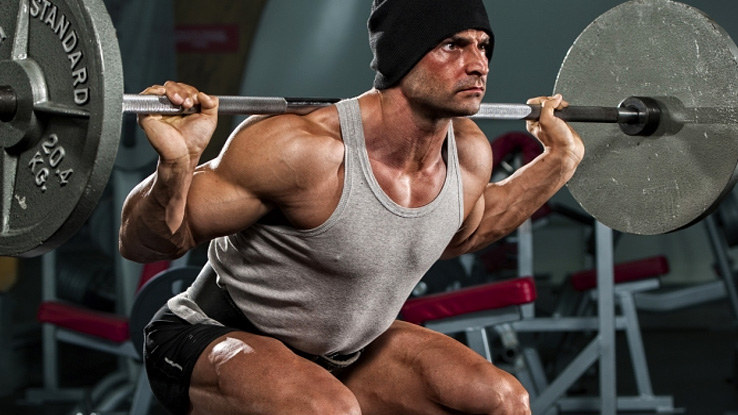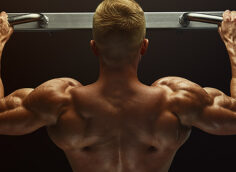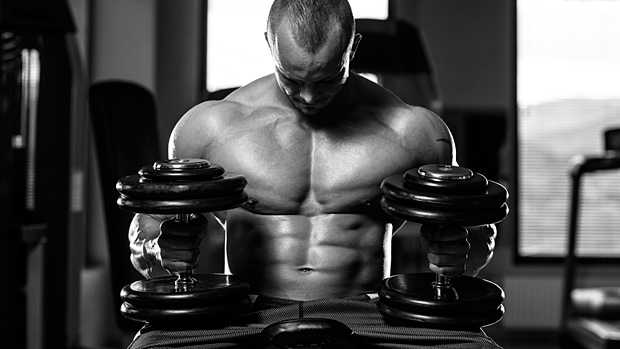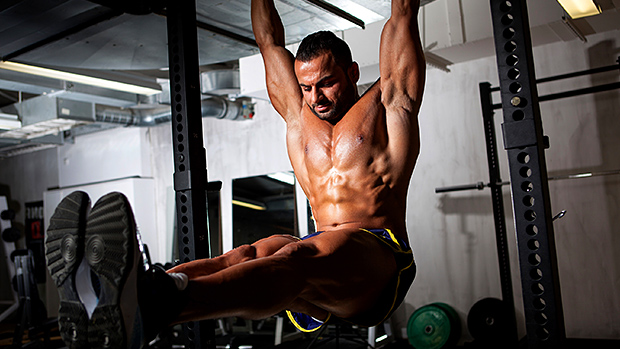My training philosophy can be summed up like this: Build a great physique by working on its capacity to perform at a high level.
After training so many athletes for performance, I realized that if you make them stronger and a lot more powerful with better strength-capacity, they'll wind up with amazing physiques in the process.
I've seen more people build great bodies "without even trying" than by doing what's typically regarded as "aesthetic work." And those who get there "without trying" usually get leaner too, without following a deprivation contest diet.
One of the explosiveness-building tools I use to improve an athlete's physique is the jump squat. It's a simple exercise that will make you violently powerful while developing dense, muscular legs. It'll also help improve almost every other exercise you do by increasing your capacity to recruit the more growth-prone fast-twitch fibers.
Better still, it's very easy to do and has many of the benefits of the Olympic lifts, without the complexity.
While there are several versions of the jump squat, you must first master the basic version before branching off. Not many people are naturally explosive, and fewer still are explosive when lifting weights, so your first goal is to learn to be violently explosive.
I've been using the jump squat with my athletes for 15 years and for even longer in my own training. I've used it with football players, hockey players, Olympic lifters, bobsleigh athletes, and other athletes of all kinds, but also with bodybuilders and figure girls. If you train it hard, it will give your whole physique a different look.
To begin, put the bar on your shoulders as if you were doing a regular squat. Bend down to the power position, which is the depth you would dip down to if attempting a maximum vertical jump (about a quarter squat for most).
Once you reach that position, violently change direction and jump straight up as high as you can. Absorb the landing by going into a quarter squat. Then stand up, reset, and start again.

- Don't dip too low. Many people mistakenly think they'll jump higher if they dip down lower. The best knee angle to jump from is about 130 degrees, or roughly a quarter squat. Even if your natural tendency is to dip lower, force yourself to only go down into a quarter squat.
- Don't bend the torso forward too much when dipping down. Many do this because they think it makes them jump higher, but what really happens is that their head travels a greater distance, giving the illusion of more height achieved. The fact is, lifters who bend their torso too far forward jump more with their back than their legs. An easy way to spot this is to look for the lifter leaning back while the hips go forward in the air.
- Focus on a violent turnaround. A rapid turnaround isn't fast enough. When you turn around it should feel as if you were punching someone with all you've got.
- Don't rush between reps. Land solidly, and then take your time to reset properly.
How Heavy?
The goal with jump squats isn't to see how much weight you can leave the floor with, but rather how much violence you can transfer to a moderate load. To that end, the number one jump squat mistake people make is going too heavy.
The optimal load for jump squats is 20-30% of your maximum full back squat, as this is where power production is highest. Remember, you don't use a hammer to paint a wall! Each method has a purpose, so stick to that purpose. Jump squats are to make you violently powerful. Therefore, use the load where power output is greatest.
How Much?
Sets of 3-5 are ideal when using the basic jump squat to improve maximum power. Sure, you could probably do 10+ awkward reps with the weight recommended, but if you're trying to be violently explosive, you won't (or shouldn't) be able to do more than 5 quality reps. Any more than that will result in an erosion in power production that's counterproductive to the goal.
As for sets, I like the total number of jumps to be around 20-25 for a workout, so that equals between 4 and 8 sets, depending on how many reps you do.
Rest?
Achieving a high workout density is important, so I always recommend using shorter rest intervals, as long as performance doesn't suffer.
When doing sets of 3 to 5 at 20-30% of your maximum, 45 seconds is the most rest anyone should need to maintain a proper violent performance. If you can do 30 seconds or less and still maintain the same level of violence, even better.
Obviously, if a set suddenly feels flat and less explosive, then extend the rest period a bit. Density is great, but maximal performance is still more important.
How Often?
I like to use a higher frequency with jump squats as they're not stressful on the muscles or tendons. While they do involve the nervous system significantly, they're more stimulating than draining, so doing your jump squats at the beginning of the session will actually allow you to perform better in that session, regardless of what else is on the menu that day.
Furthermore, most people aren't naturally explosive, but if they become more explosive they'll build muscle easier. Being explosive is a motor skill, though, and learning a motor skill requires a high frequency of practice.
In other words, starting every workout with jumps squats is perfectly fine and a great way to reprogram your body and get great gains in muscle and strength.
While the main purpose of the basic jump squat is to make you violently powerful and make your muscles look harder, you can use variations of the exercise to slightly alter the type of gains you achieve.
Jump-squat series to burn more fat
The main difference with the jump-squat series is that you don't reset between reps. When you land, go back down to a quarter squat and jump as high as you can again.
The power output of the jump squat series is a bit lower, so I recommend doing at least two sets of basic jump squats first to warm-up the movement pattern and get the max power stimulation.
In the jump squat series, use 15-25% of your max squat weight and perform as many jumps as you can in a specific period of time (20-30 seconds is recommended).
Be careful not to "cut your jumps" – many lifters that want to fit more jumps in the 20-30 second block fail to finish their jump (they don't jump as high as they can). On the contrary, every jump should be done violently and explosively, especially when fatigue sets in.
Contrast jump squats to build the quads
In the contrast variation you dip down to your regular depth (quarter squat), but instead of violently changing direction, you pause for a solid 3 seconds and then – without re-bending the knees farther –jump up violently as high as you can. Do sets of 5 repetitions and after the last rep go down to a half-squat position and hold it for 30 seconds.
The jumping increases the activation of the fast-twitch fibers, which stay turned-on during the isometric hold. That hold will stimulate the fibers and increase growth factor production, leading to more size.
Low squat primed jump
This is my favorite variation for building a bigger and stronger lower body. It also has great transfer to sprinting speed. Use 20-30% of your maximum squat and combine partial squats with jumps.
Go down into a full squat. From the full squat, go up to the quarter squat position and then back down to the full squat. Repeat for 3 reps, but when you hit the third rep, don't stop at the quarter squat position – jump as high as you can. The 3 bottoms squats plus the jump is equal to one repetition and I recommend you perform 3 to 5 reps per set.
If you're not working hard on loaded jumps, then you're missing out on serious growth and body transformation potential. Become super powerful, super strong, and super resilient and you will look like an absolute beast.





